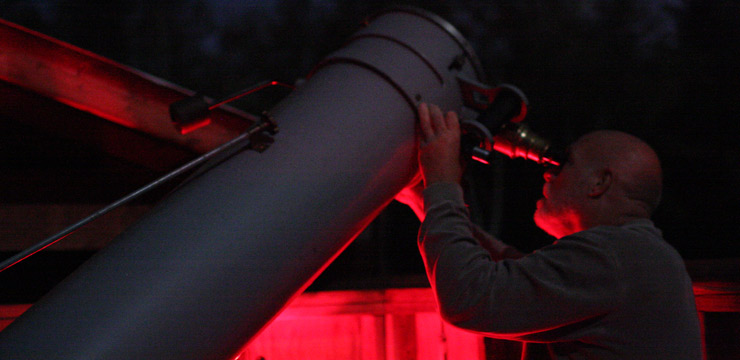Occultation/Graze of Antares by Moon: June 6, 2009
June 2009 :
I have watched the Moon occult stars in the Pleiades star cluster on many occasions. And I have also observed the Moon occult a planet or two during my 37 years of amateur astronomy. But just seeing a single star either pass behind the lunar limb or move tangentially to it never seemed to interest me.
Fortunately at the June monthly meeting of Skyscrapers, Bob Napier reminded everyone of the June 6 (Saturday night) occultation or graze of the bright star Antares (Scorpius) by the Moon. Here in Rhode Island we would be very close to the graze/occultation limit. I did not review any details about the event beforehand, but it was my belief my location up here in Pascoag would be north of the occultation point, but perhaps I would be able to observe a graze which would show Antares blinking in and out between lunar mountain valleys or crater walls along the limb.
During the late afternoon and early evening my wife and I attended a wedding shower down in Warren on the Bay. Soon after sunset low clouds rolled off the Bay and completely obscured the sky. Perhaps these clouds would not penetrate far inland I thought. Well, they did. On the ride home I got to Chepachet before the Moon was finally seen in a cloud-free sky. And it was perfectly clear at home in Pascoag at about 9:30 pm.
The Moon, only a few hours from full, was traversing a low trajectory across the southern sky. I knew I would not be able to observe the event from my high tree-lined property. I picked out a spot across the street at my neighbor’s house where the tree-line towards the south would not block the Moon.
The event was to occur approximately between 11:00 pm to 11:30 pm. At around 10:45 pm I carried my 4 ¼-inch f/5 reflector across the street. And what did I see? Those clouds had finally reached further inland. Overhead was still clear, but the clouds (reminded me of the marine layer in San Diego) varying in thickness were constantly covering and uncovering the Moon. And these clouds were moving very fast. They looked more like smoke from a big fire than clouds, especially when they passed in front of the Moon.
I started observing with a 12mm eyepiece then quickly chose an 8mm, giving me a magnification of 64. Right away I could see Antares a short distance from the lunar limb. As the time passed I could see the distance between these two bodies decreasing. I still believed Antares would stay just beyond the lunar limb. Closer and closer they became. But then it seemed the two were not getting any closer. It looked like Antares was moving tangentially to the lunar limb. Actually, the Moon was moving eastward amongst the stars. I noted several “bumps” (mountains/craters) and watched Antares move relative to them. With the Moon just shy of being full, I thought possibly I’d see Antares disappear behind the slight unlit portion of the lunar surface.
The clouds thickened and thinned constantly, causing me to look toward the sky, then back to the eyepiece every few seconds. It was like watching a tennis match. And the turbulence or scintillation caused by the unstable air made it difficult to note whether Antares was passing in front of a limb feature or not. I decided it was not at this time.
Antares continued to “move” relative to the features. I noticed what seemed to be a “pocket” on the limb, a little indentation. Perhaps it was a small valley or a crater wall. Antares seemed to sit right in it. Just before it got to this location it seemed like I was watching some “vehicle” skim above the lunar surface.
A thick mass of clouds obscured my view for a couple of seconds, and when the Moon was back to full brightness, Antares was gone. Though the scintillation had gotten a bit worse, I do not think it was responsible for my losing sight of Antares. Antares was occulted by the Moon at approximately 11:10 pm.
Fortunately the cloud situation did not worsen. In fact, they seemed to retreat south of the Moon’s location. I kept a vigilant eye on the lunar limb and at approximately 11:22 pm I observed Antares emerge from the edge of the Moon. I continued to observe for about 10 minutes, all the while watching as the lunar limb moved farther and farther from this red giant star.
I picked up my scope and chair and returned them to my garage. Though I did not keep accurate time measurements down to the second, when I checked my timings the next morning against the predictions for Providence (disappearance: 11:10:17pm; reappearance: 11:21:09 pm), I was pleased to confirm my measurements were in line with what was expected.
All in all I had a good observing session, and I encourage others to give it a try sometime in the future. And dozens of fireflies and a few mosquitoes kept me company the whole time. I know I will be out there should a future event be as conveniently well placed to observe.
Related Topics




